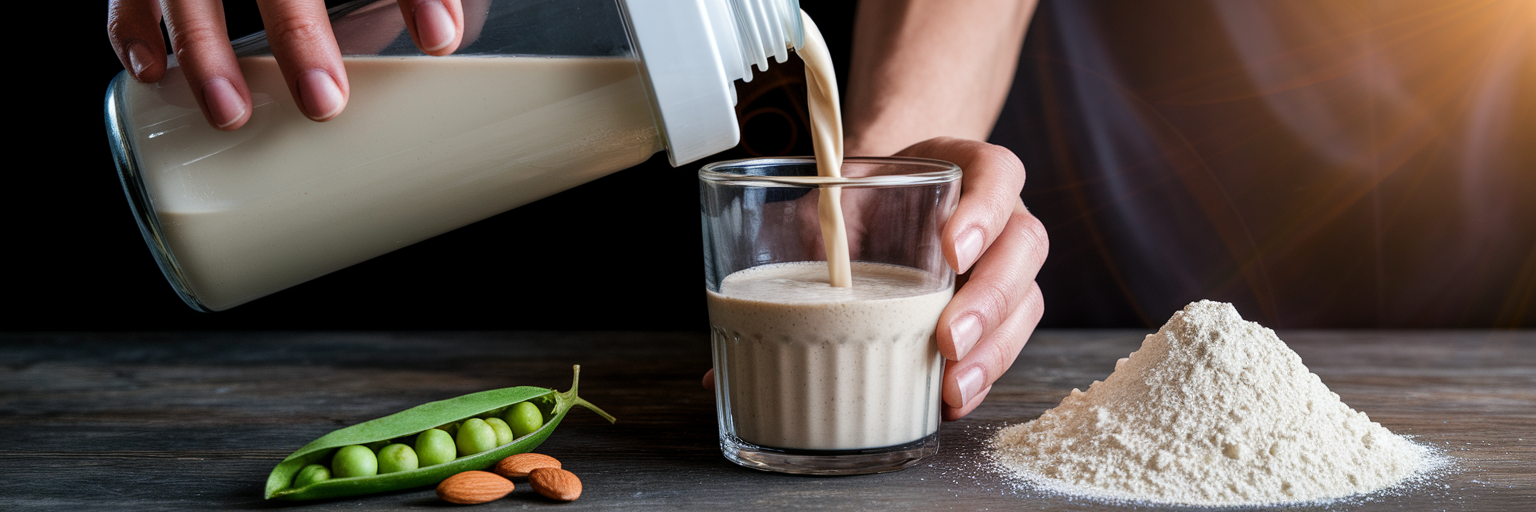Why Creatine Is a Vegan Fitness Ally
If you're a vegan athlete, you know the dedication it takes. You meticulously plan your meals and train with intensity, but sometimes you hit a wall where your strength and power gains just seem to stall. What if there was a simple, plant-friendly tool to help you push past that plateau? For many, that tool is creatine monohydrate.
Let's clear up a common misconception right away: creatine is not an animal product. While it's found naturally in meat, the creatine in supplements is synthetically produced in a lab, making it completely vegan. You can supplement with confidence, knowing it aligns perfectly with your ethical choices.
At its core, creatine helps your muscles produce energy during short, intense bursts of effort, like lifting weights, sprinting, or jumping. It’s one of the most researched supplements on the planet, known for its ability to support strength and performance.
This guide will walk you through everything you need to know. We'll cover how to choose a high-quality product, the best ways to incorporate it into your routine, and how to avoid any potential side effects. Think of it as your roadmap to getting the most out of your plant-powered training.
The Science Behind Creatine for Plant-Based Athletes
So, how does creatine actually work? Think of your muscle cells as having tiny, rechargeable batteries that power every contraction. This energy is called ATP. When you perform an explosive movement, you use up that energy fast. Creatine acts like a charging station, helping to rapidly replenish ATP so you can squeeze out those extra reps or sprint a little harder.
Here’s where it gets particularly interesting for plant-based athletes. Because vegan and vegetarian diets don't contain dietary creatine, your baseline muscle stores are naturally lower. This isn't a bad thing, but it does mean that when you start supplementing, the effects can be more noticeable and significant. You’re essentially filling a tank that was running on low, giving your muscles a readily available energy reserve they didn't have before.
Supplementing with creatine for vegans saturates your muscles with a compound called phosphocreatine. This is the high-energy molecule that donates its phosphate group to regenerate ATP, fueling your performance when you need it most. But the benefits might not stop at the gym. According to a study in the journal Nutrients, creatine supplementation can also support brain health, which is a fantastic bonus for anyone with no dietary intake. You can explore the many creatine benefits in more detail if you're curious about the broader research.
Choosing a High-Quality Vegan Creatine

Walking down the supplement aisle can be overwhelming, but choosing the right creatine is simple. You just need to know what to look for on the label. Your goal is to find a pure, effective product without any unnecessary extras.
First, look for the words "creatine monohydrate." This is the most studied, effective, and affordable form of creatine available. While other forms exist, monohydrate has the strongest scientific backing. Next, ensure the product is clearly marked with a "vegan" certification. This guarantees no animal-derived ingredients were used in its production.
Purity is key when selecting vegan fitness supplements. A top-tier creatine supplement should be just that: creatine. Avoid products with added fillers, sugars, or artificial ingredients. To be extra sure of what you're getting, look for a third-party testing seal like NSF Certified for Sport or Informed-Sport. These certifications verify that the product is pure and free from contaminants or banned substances.
You might also see the term "micronized" creatine. This simply means the powder has been broken down into smaller particles. The benefit? It dissolves more easily in water, which can reduce any potential for grittiness or stomach discomfort. When you're ready to choose, finding a pure creatine monohydrate is the best first step.
Your Daily Creatine Routine: Timing and Dosage
Now for the practical part: how to take creatine for the best results. The single most important rule is consistency. The goal is to keep your muscle creatine stores fully saturated, and that requires taking it every single day, including on your rest days.
The scientifically proven dose for most people is 3-5 grams per day. It’s simple, effective, and easy to remember. You may have heard about a "loading phase," which involves taking around 20 grams daily for a week to saturate your muscles faster. While this works, it's completely optional and can increase the chance of minor side effects like bloating. For most athletes, sticking with a steady 3-5 grams daily is the ideal approach. It will get you to the same place in about three to four weeks without any rush.
What about the best time to take creatine? People debate pre-workout versus post-workout, but the truth is, it doesn't make a huge difference. Some studies suggest a slight edge to taking it post-workout, but the benefit is minimal. As publications like Men's Health confirm, the best time is whenever you will consistently remember to take it. Mix it in your morning smoothie, your post-workout shake, or a glass of water in the afternoon. Just pick a time and stick with it.
| Factor | Loading Phase | Daily Maintenance |
|---|---|---|
| Goal | Fastest possible muscle saturation | Gradual saturation and long-term maintenance |
| Daily Dose | Approx. 20 grams (split into 4 doses) | 3-5 grams (one dose) |
| Time to Saturation | 5-7 days | 3-4 weeks |
| Potential for Side Effects | Higher (bloating, stomach discomfort) | Very low |
This table compares the two common dosing methods. For most users, the Daily Maintenance approach is simpler, more cost-effective, and better tolerated.
The Power Couple: Creatine and Vegan Protein

To truly maximize your results, think of creatine and vegan protein as the ultimate power couple. They work together to help you build strength and recover effectively. Here’s how: creatine gives you the energy to push harder and lift heavier during your workouts. This intense effort creates a powerful stimulus for your muscles to grow stronger.
That’s where protein comes in. After you’ve challenged your muscles, vegan protein and creatine work in tandem. The protein provides the essential amino acids—the building blocks—your body needs to repair the muscle fibers and rebuild them stronger than before. Without enough protein, you're missing a critical piece of the recovery puzzle.
The easiest way to combine them? Simply mix your 3-5 gram dose of unflavored creatine directly into your post-workout vegan protein shake. This is an incredibly efficient way to refuel your energy stores and kickstart muscle repair simultaneously. When choosing a protein, look for high-quality sources:
- Pea Protein: A popular choice, rich in branched-chain amino acids (BCAAs).
- Soy Protein: A complete protein containing all nine essential amino acids.
- Brown Rice Protein: A good hypoallergenic option that pairs well with pea protein.
- Hemp Protein: Offers a bonus of healthy fats and fiber.
- Blended Plant Proteins: Often combine multiple sources (like pea, rice, and pumpkin seed) to create a complete and robust amino acid profile.
If you're looking for a great-tasting option, a chocolate vegan protein can make your post-workout routine feel like a treat. If you found this tip helpful, share it with a vegan friend who's also on their fitness journey!
How to Prevent Bloating and Other Side Effects
Let's talk about the most common concern people have with creatine: bloating. The fear of creatine bloating side effects is understandable, but it's almost always preventable. Here’s what’s happening: creatine works by pulling water into your muscle cells. This is a good thing—it’s part of the process that helps with energy production and muscle fullness. Bloating can occur when your body, in a state of dehydration, tries to hold onto water in other tissues.
The solution is surprisingly simple. By following a few easy steps, you can enjoy all the benefits of creatine without the discomfort. Here are the most effective strategies:
- Stay Hydrated: This is the most important step. Aim to drink plenty of water throughout the day to help creatine do its job inside the muscles.
- Stick to the Recommended Dose: A daily dose of 3-5 grams is effective. Avoid taking more than you need.
- Split Your Dose: If a single 5-gram serving feels like too much, try taking two smaller 2.5-gram servings at different times.
- Consider Micronized Creatine: The finer powder dissolves more easily and may be gentler on your digestive system.
Remember, creatine is one of the safest and most studied supplements available. Side effects are rare and typically a sign that you just need to adjust your water intake or dosage. For any other questions, a good FAQ page can be a helpful resource.



